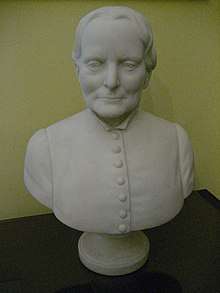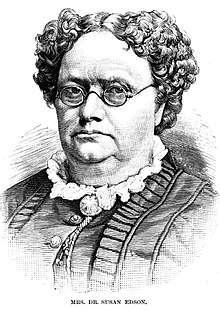Caroline B. Winslow
Caroline Brown Winslow (November 19, 1822 – December 7, 1896) was an American physician, and the fifth woman in the United States to graduate in medicine.
Caroline B. Winslow | |
|---|---|
.jpg) Winslow from the 1895 book A woman of the century | |
| Born | Caroline Brown November 19, 1822 Appledore, Kent, England |
| Died | December 7, 1896 (aged 74) Washington, D.C., United States |
| Nationality | American |
| Other names | Caroline Brown Winslow |
| Occupation | Medical doctor |
| Known for | Being the fifth woman in the United States to graduate in medicine |
Early life
Caroline Brown was born in Appledore, Kent, England, on November 19, 1822, the daughter of Samuel Brown (d. 1857). The family moved to the United States in 1826.[1][2]
In 1850 she studied human anatomy under Rachel Brooks Gleason, M. D., at Glen Haven, New York and in December 1851 entered the Eclectic Medical College, in Cincinnati, Ohio, graduating in June 1853. She was the first woman to graduate from that college and the fifth woman in the United States to graduate with a degree in medicine.[1][2]
Career

Caroline B. Winslow practiced successfully in Cincinnati from 1853 to 1859 and having become interested in homeopathy, graduated in 1856 from the Western College of Homeopathy in Cleveland, Ohio. She then went to Utica, New York, the home of her parents, where she remained for more than seven years. In April 1864, after the death of her parents, she went to Washington, D. C., where she served as a regular visitor in military hospitals under the auspices of the New York State Agency. After the Civil War, she spent eight months in Baltimore, Maryland, before settling in Washington where she set up a homeopathy practice.[1][2]
In November 1882, together with Susan Ann Edson, she opened the Homeopathic Free Dispensary, the first homeopathic pharmacy in Washington, which flourished for some years. It was the first facility where women doctors could practice side-by-side with their male colleagues.[1][3]
She was president for fourteen years of the Moral Education Society of Washington. She edited the Alpha, the journal of that society, for thirteen years. She was a woman-suffragist and an advocate of higher education for all.[1]
She was part of the Universal Franchise Association and together with Edson she planned the 1869 conference of the Universal Franchise Association.[1][4][5]
In 1893 sculptor Adelaide Johnson made a bust of Caroline Brown Winslow which was exhibited in the Rotunda of the Woman's Building of the World's Columbian Exposition.[6]
Personal life

Caroline Brown married Austin Crosby Winslow, an artisan, on July 15, 1865, when Winslow was 43 years old.[1]
Winslow was the lifelong friend of Susan Ann Edson. They probably met at Eclectic Medical College, which both attended. During the Civil War they worked as nurses, as they were not allowed to act as doctors. After the war, Winslow and Edson moved to Washington, D.C., together and established their own practices. Together they wrote a missive to the Congress, The Right of Women to Vote.[5] Winslow adopted her niece, Mary Brown McPherson Janney (1853–1928), after the death of her sister.[2]
Caroline B. Winslow died on December 7, 1896. Susan Ann Edson died one year later, in 1897. They are both buried at Rock Creek Cemetery, Washington.[7]
References
- Willard, Frances Elizabeth, 1839-1898; Livermore, Mary Ashton Rice, 1820-1905 (1893). A woman of the century; fourteen hundred-seventy biographical sketches accompanied by portraits of leading American women in all walks of life. Buffalo, N.Y., Moulton. pp. 790–791. Retrieved 8 August 2017.

- "History of Homeopathy Biographies". Retrieved 26 August 2017.
- Moldow, Gloria (1987). Women Doctors in Gilded-age Washington: Race, Gender, and Professionalization. University of Illinois Press. p. 12 and 77. Retrieved 26 August 2017.
- Norgren, Jill (2007). Belva Lockwood: The Woman Who Would Be President. NYU Press. p. 267. Retrieved 26 August 2017.
- "Susan Edson, President Garfield's Deathbed Physician". Retrieved 26 August 2017.
- "Adelaide (Sarah Adeline) Johnson (1859–1955)". Archived from the original on 2017-06-05. Retrieved 26 August 2017.
- "Letter, Susan B. Anthony to Adelaide Johnson discussing women ministers and Johnson's sculpture memorializing prominent suffragists, 8 February 1896". Retrieved 26 August 2017.